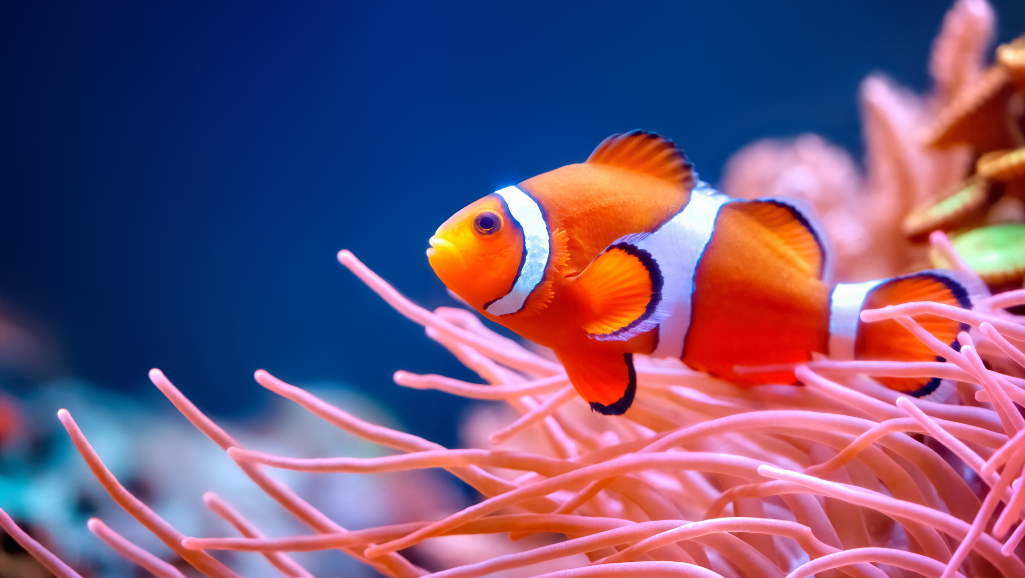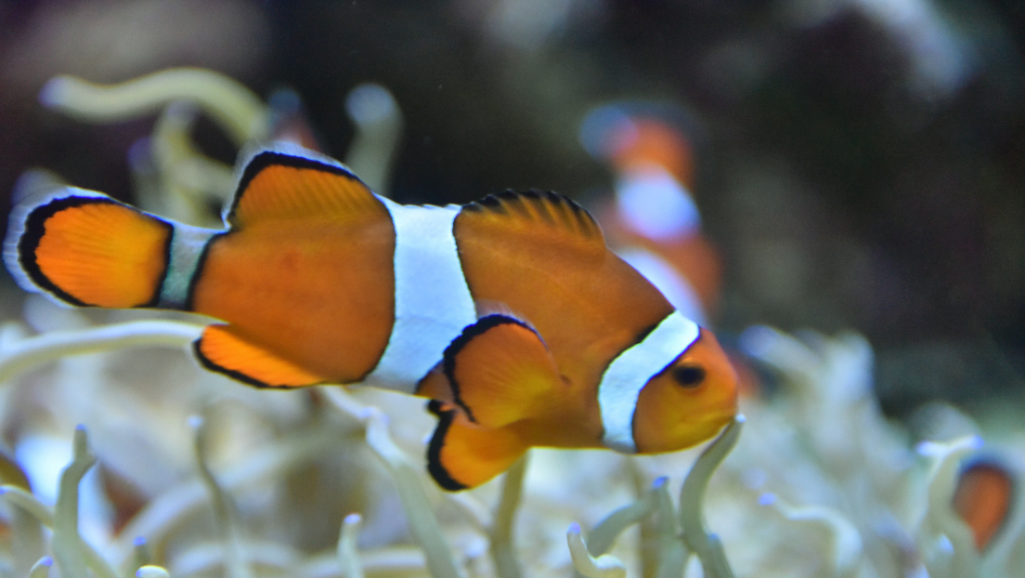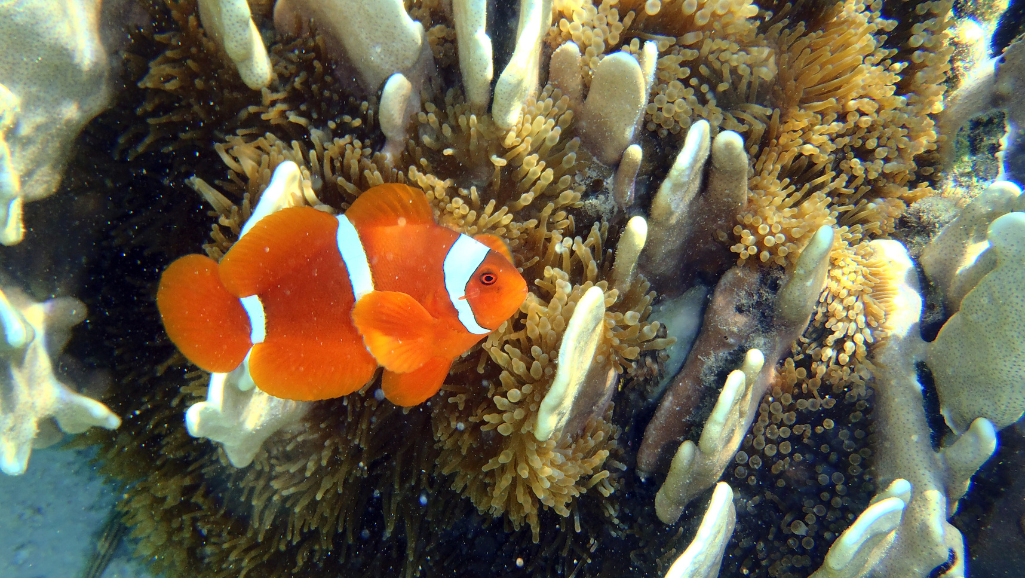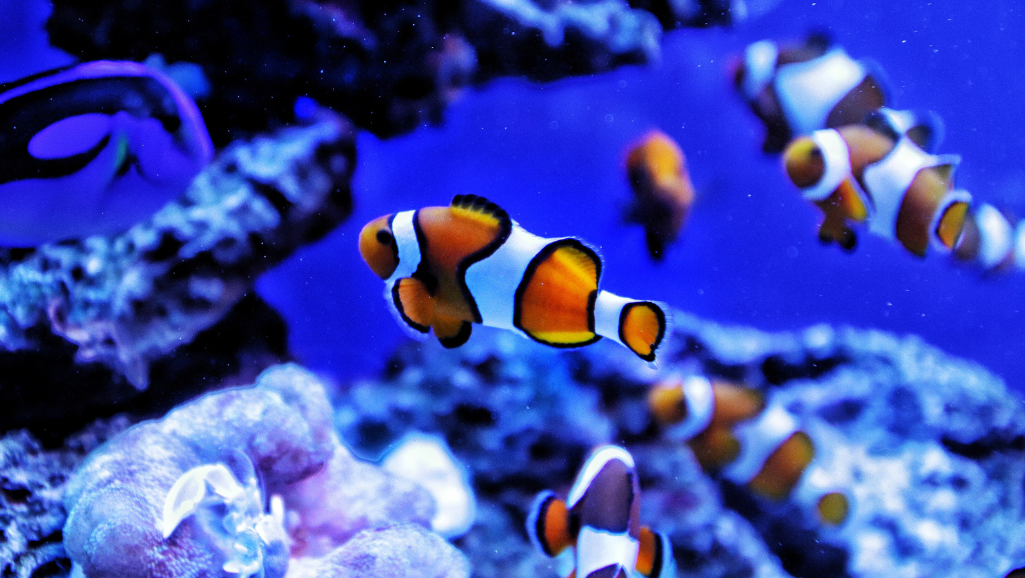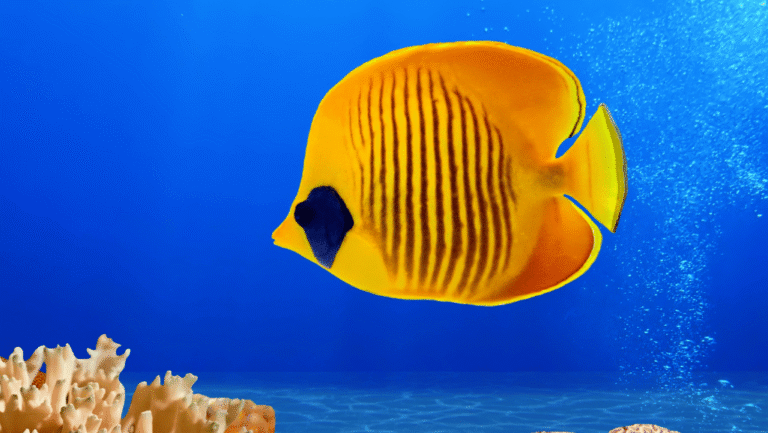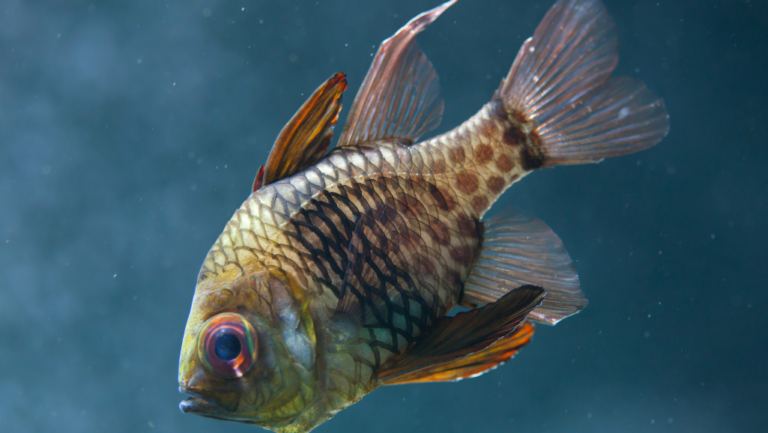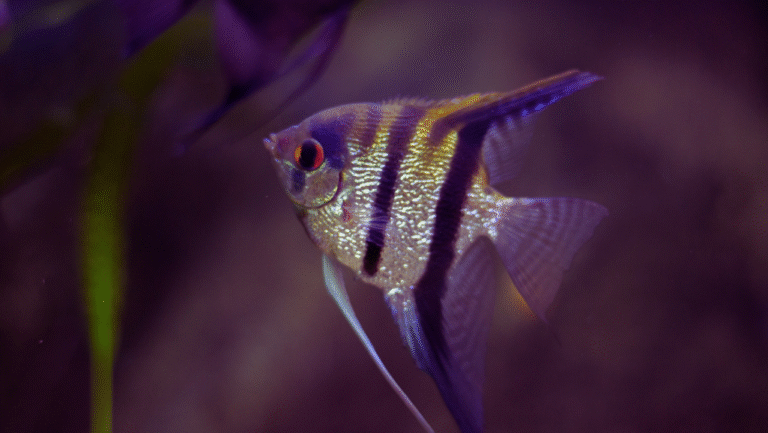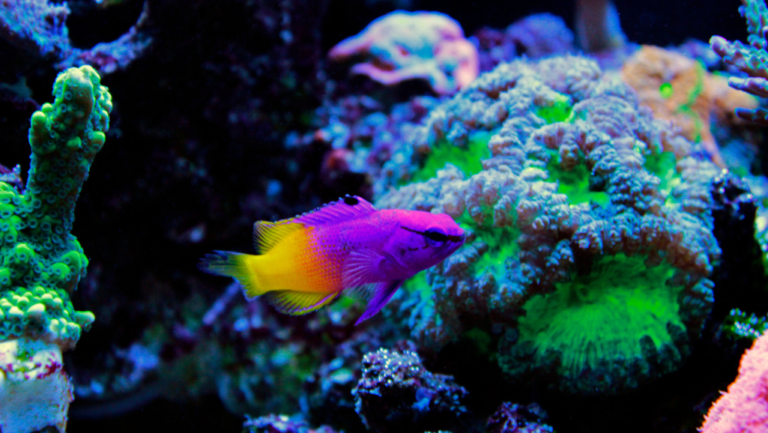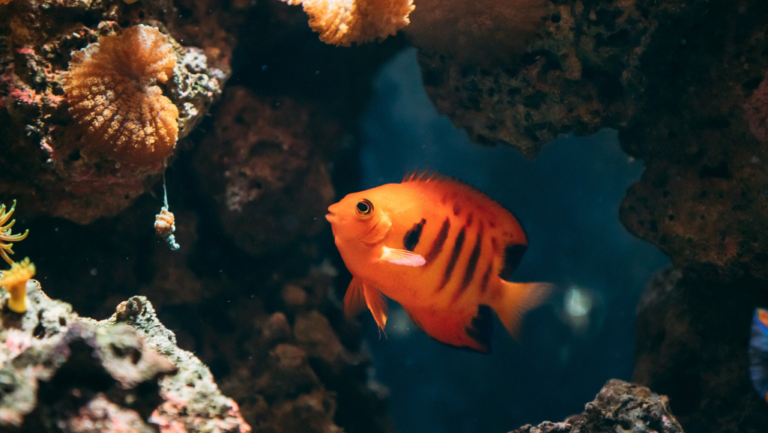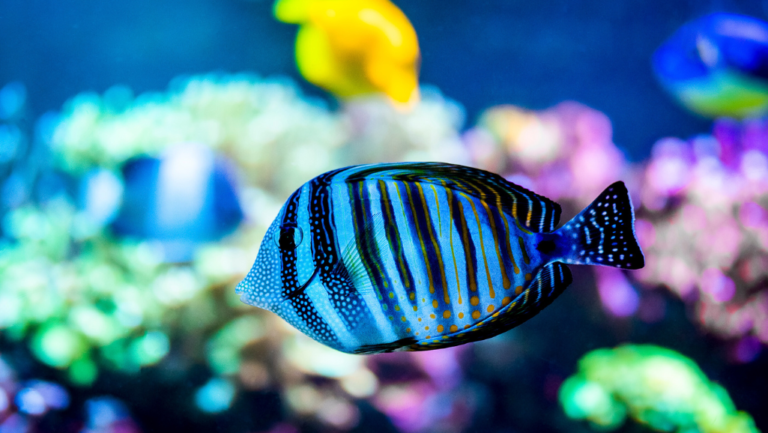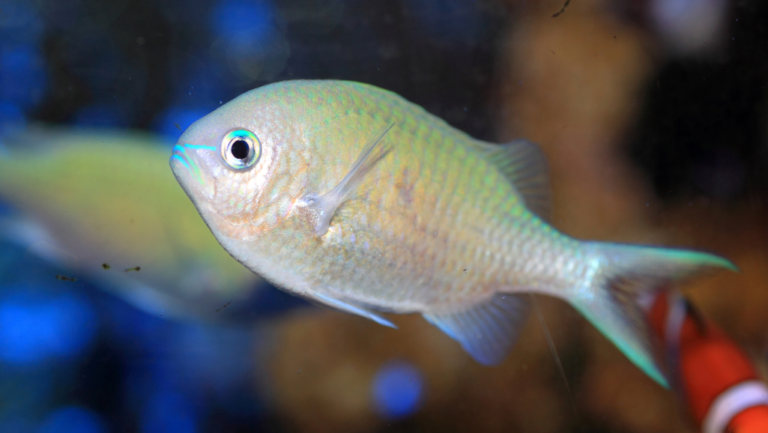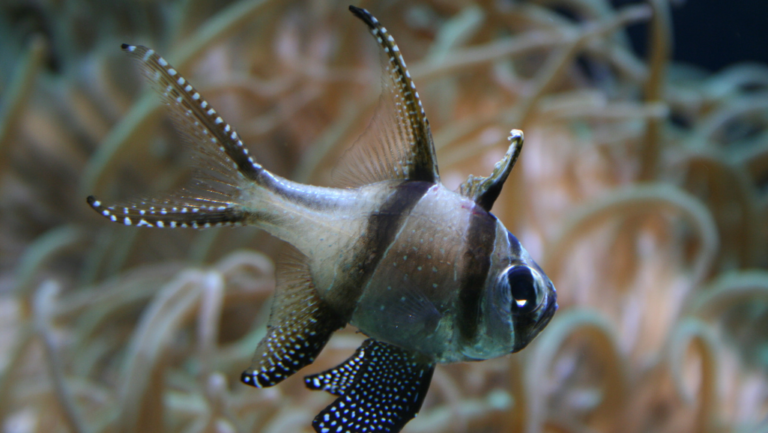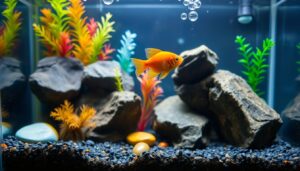Clownfish, or Amphiprioninae, are a key part of the marine ecosystem. They are found in warm waters from the Red Sea to the Pacific Ocean. These colorful fish are not just pretty; they play important roles in their underwater world.
Clownfish live with sea anemones in a special partnership. This shows how nature’s creatures depend on each other. They are also known for their ability to change sex and communicate through sounds, building strong social bonds.
Learn more about these amazing sea creatures by reading top ten facts about clownfish. These facts highlight their unique behaviors and their role in the marine ecosystem. Whether you’re an aquarist or just love the ocean, knowing about clownfish is important, as experts at AquaJoyLife explain.
Key Takeaways
- The Clownfish family includes around 30 species, with the common clownfish (Amphiprion ocellaris) as one of the most renowned.
- These fish typically weigh between 42 and 70 grams, reflecting their small size in the marine ecosystem.
- Clownfish can live up to 12 years in captivity, whereas in the wild, their lifespan averages around 8 years.
- Unique among many marine species, clownfish possess the ability to change sex, with all clownfish born male; this process, once undergone, is permanent.
- Communication among these creatures is facilitated through distinctive popping and clicking noises, which serve various social functions including attracting mates and establishing territory.
- The child-rearing responsibilities in clownfish social structures fall heavily on males, demonstrating an interesting dynamic within their communities.
- With environmental shifts and burgeoning demand for home aquariums, it’s critical to consider conservation efforts to protect these vibrant constituents of the marine ecosystem.
Introduction to Clownfish
The world of clownfish is full of color and wonder. It fascinates both marine lovers and those who care about the environment. Clownfish are known for their clown-like appearance. They come in many bright colors and patterns. These colors help them survive in their Clownfish habitat, found mainly in the Red Sea and the Pacific Ocean.
There are about 30 different clownfish species. Each one has its own special look. The Ocellaris Clownfish is the most famous, with its orange and white stripes. But there are others like the Percula, Tomato, and Clark’s Clownfish, each with their own colors and patterns.
While commonly recognized for their endearing appearance, clownfish are fascinating for their unique bond with sea anemones. This bond lets them live in places where few other fish can. It makes them very important to the health of the reefs.
- Threatened Habitats: Clownfish face big challenges because of changes in their environment. Things like coral bleaching and pollution harm their homes. This affects the whole ecosystem.
- Conservation Efforts: Knowing what clownfish need helps us protect them better. This way, we can make sure they keep entertaining us for years to come.
Clownfish are not just known for their looks. They are also very resilient. They remind us of the beauty and complexity of life under the sea. Their survival is key to protecting the ocean’s delicate balance.
The Unique Characteristics of Clownfish
Clownfish are a bright spot in the ocean, known for their unique traits. They stand out with their bright colors and interesting life cycle. Each feature plays a key role in their place in the sea.
Coloration and Patterns
Clownfish are famous for their bright colors and patterns. They often have a bright orange body with white bands. But, they can also be pink, red, yellow, black, or brown.
These colors help them hide in coral and also help with finding friends and mates.
Size and Body Shape
Clownfish are perfectly sized and shaped for their home in the reef. They are usually 2 to 5 inches long. Their small, streamlined bodies let them quickly move through coral.
Being small doesn’t mean they’re shy. They are actually quite bold, often defending their territory.
Life Span
Clownfish can live a long time, up to 12 years in captivity. In the wild, they live about 8 years. Their long life is helped by their special way of reproducing.
All clownfish start as males. The biggest one can turn into a female. This helps the species survive and thrive.
Clownfish are truly special, with their bright colors, perfect size, and long life. These traits help them survive in tough places. They also make them fascinating to study and watch.
Habitat and Distribution of Clownfish
The clownfish is a bright and key part of the sea’s life. They love warm waters and live mostly in sheltered reefs or calm lagoons. These places are not just homes but are vital for their survival and growth. The warm waters of the Red Sea and Pacific are perfect for them to thrive.
Where They Live
Clownfish pick their homes carefully, looking for places with lots of hiding spots and places to breed. The warm waters of the Indian and Pacific oceans are their big playgrounds. Here, the ocean’s currents and rich life create a safe space for different clownfish species.
Popular Species by Region
- Common Clownfish: You’ll find them in the lagoons and sheltered reefs of the Indo-Pacific.
- Percula Clownfish: They’re common in Australia’s Great Barrier Reef and Southeast Asia. They love the warm, shallow waters for breeding and socializing.
Learning about clownfish habitats helps us understand the sea better. It shows how these fish keep their ecosystems balanced. Whether in Indo-Pacific reefs or Red Sea lagoons, each group is vital for the sea’s health.
The Symbiotic Relationship with Anemones
The bond between clownfish and sea anemones is a fascinating example of mutualism. Both species benefit greatly from their connection. This symbiotic relationship helps the clownfish thrive and boosts the anemones’ health and growth. Together, they create a balanced ecosystem in the sea.
Clownfish, known for their bright colors and lively movements, can live safely among the anemone’s venomous tentacles. They have a special mucus that protects them. This setup keeps the clownfish safe from predators and helps the anemone grow by using the clownfish’s waste as nutrients.
Researchers, like those at Auburn University, have found that this partnership is more than just living together. The clownfish’s waste is like fertilizer for the anemone. It improves the anemone’s breathing and health.
- The mutualism also helps protect against bacteria. Changes in the microbiota of both help create a healthier environment.
- This idea has inspired new ways to manage resources in industries. It shows how nature’s strategies can help us use resources better.
The connection between clownfish and sea anemones is a marvel of marine life. It shows the complex dependencies and balances in nature. Their unique living arrangement highlights the power of symbiotic relationships. It shows how different species can work together for their survival and success.
Diet and Feeding Habits of Clownfish
Clownfish are fascinating marine creatures known for their bright colors and unique diet. Their clownfish diet and feeding habits help them survive in both wild and captive environments. This knowledge is key to their health.
Clownfish are omnivores, eating both plants and animals. They munch on small invertebrates like zooplankton and copepods. They also eat algae and small crustaceans, keeping their diet balanced.
What Do They Eat?
- Zooplankton and copepods
- Larvae and small shrimp
- Algae and other plant matter
- Occasional small fish eggs
The clownfish diet varies based on their habitat and food availability. They live in anemones, which protect them and attract prey.
Hunting Techniques
Clownfish use clever marine hunting techniques. They live in anemones, which keep predators away. The anemones also lure in small creatures for the clownfish to eat.
In captivity, it’s vital to feed clownfish like they do in the wild. They need high-quality marine pellets and vitamin-rich foods. Feeding them the right amount helps keep their tank water clean.
By understanding and mimicking their feeding habits and marine diet, we can help them thrive. This closely mirrors their natural marine hunting techniques.
Reproduction and Life Cycle
The life cycle of clownfish is truly fascinating. It involves clownfish reproduction and survival in the ocean. Clownfish are special because they can change sex, usually from male to female. This helps them adapt to their environment and increase their chances of marine breeding.
Breeding Habits
Clownfish have a unique way of reproducing, linked to their home around sea anemones. They lay eggs on flat surfaces near the anemones. This provides a safe place for their babies, thanks to the anemone’s stinging tentacles.
On average, clownfish lay between 100 and 1500 eggs per breeding cycle. These pairs are monogamous and breed many times a year. They time their egg hatching with the lunar cycles to help their babies survive.
Parental Care
The care that clownfish give to their young is key to their survival. Male clownfish are very dedicated, aerating the eggs with their fins. This is important at night when oxygen levels are low.
Clownfish are very committed to child-rearing. This dedication helps a lot of their babies survive. In the wild, where many predators exist, this is very important.
Learning about clownfish reproduction and child-rearing shows how complex their life cycle is. It also highlights the need to protect these amazing creatures. This ensures they keep playing a vital role in coral reef biodiversity.
Interesting Behaviors of Clownfish
Clownfish are known for their bright orange color and lively nature. They have unique behaviors that help them survive and rule their marine territories. Their territorial clownfish instincts and clownfish social behavior are truly fascinating.
Territorial Nature
Clownfish are very territorial. They pick a spot, usually around a host anemone, and defend it fiercely. Each group has its own anemone, which they guard against any intruders.
They even nip at divers or other threats to protect their territory. This shows how dedicated they are to defending their home.
Dr. Kina Hayashi’s research at the Okinawa Institute of Science and Technology supports this. It shows they are aggressive not just to other species but also to each other. This aggression is often aimed at those who look similar.
This highlights the complex nature of their territorial behavior. It even involves fighting among themselves based on looks.
Social Structures
Clownfish groups have a clear hierarchy. There’s an alpha female, the biggest and most aggressive, followed by a beta male. Then there are smaller, non-breeding juveniles.
If the alpha female dies, the beta male changes sex to become the new alpha female. This keeps the group’s social structure intact.
Clownfish also adjust their hierarchy based on size and aggression. This shows they are adaptable in their social structure. It helps them breed better and survive by focusing on the strongest genes.
Learning about these behaviors is not just interesting. It also helps in protecting clownfish. It guides conservation efforts to keep them safe in changing marine environments.
Conservation Status of Clownfish
Clownfish are known for their bright orange color and their special bond with sea anemones. They are not yet listed as endangered. But, their popularity in aquariums, thanks to movies and media, is a big threat to them.
Threats to Survival
Clownfish face many dangers that threaten their survival. Habitat loss, mainly from coastal development and pollution, harms coral reefs and sea anemones. These are key for their protection and breeding.
Also, too many are taken for aquariums, which has cut down their wild numbers. Ocean acidification, caused by more carbon dioxide, hurts their sense of smell and hearing. These are vital for avoiding predators and talking to each other.
Efforts to Protect Clownfish
There are many ways to protect clownfish. These include protecting marine areas and making the aquarium trade more sustainable. Governments and groups are pushing for rules to limit how many are taken from the wild.
In the U.S., some clownfish species might be protected under the Endangered Species Act. This shows growing awareness of their need for conservation.
- Marine Protected Areas (MPAs): MPAs help keep important habitats safe. They can help restore clownfish and anemone populations.
- Captive Breeding Programs: Breeding clownfish in captivity can lower the need for wild ones. This helps protect their natural numbers.
- Public Awareness Campaigns: Teaching aquarium fans and the public about responsible pet ownership is key. It helps move towards more sustainable choices.
These efforts are essential for keeping clownfish safe in their homes and for the health of our oceans.
Conclusion: The Importance of Clownfish in Marine Ecosystems
The clownfish ecosystem role is more than their cute looks and sea anemone friends. They are key to marine biodiversity, helping coral reefs and loved by marine fans. They keep algae from harming coral, supporting many marine creatures.
With 30 clownfish species, each is vital in both wild and aquarium settings. Their health is essential for marine ecosystem balance.
But, clownfish face dangers like pollution, climate change, and overfishing. The #30×30 initiative aims to protect 30% of oceans by 2030 for species like clownfish. Marine protected areas and sustainable fishing are hopeful signs for their future.
Learning about clownfish and their friends can be fun at aquariums. A good aquarium design shows us underwater beauty and teaches about conservation. Aquarium animals remind us of the importance of marine life. We must protect their world for future generations.
